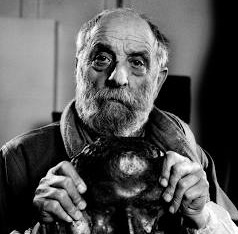
César Baldaccini
César Baldaccini, known as César, was a notable French sculptor in the 1960s. He created substantial sculptures formed by the compression of crushed automobiles, discarded metal, rubbish, domestic objects, and even jewelry. Collaborating with Louis Vuitton and Cartier, he transformed iron into delicacy and elevated trash to elegance.
Biography of César Baldaccini
César Baldaccini was a French sculptor born in Marseilles in 1921 to Italian parents from Tuscany. At the age of 12, he left school to work, but three years later, he enrolled in evening classes at a local art academy. In 1943, he earned a scholarship to the École des Beaux-Arts in Paris, where he resided for the remainder of his life.
In the early 1950s, facing financial constraints that prevented him from acquiring expensive materials, he discovered the potential of scrap iron. In 1952, he began creating sculptures by welding together pieces of scrap metal, which later evolved into his bestiary — a series featuring insects, various animals, or nudes. Thus, the "Compression" series was born.
His inaugural solo art exhibition occurred in 1954 at the Galerie Lucien Durand in Paris, with his first "Compression" displayed in 1958. For his nudes, the remarkable and colossal "Sein" was shaped after a cabaret dancer's breast and cast in pink polyester resin, possibly invoking indirect echoes of Marcel Duchamp's "Prière de toucher."
To create many of his works, César used a hydraulic press, a welding torch, or occasionally a sledgehammer. The artist experimented with diverse materials, applying the same welding technique to jewelry. He crafted new pendants and pieces by crushing old rings and necklaces. César developed a series using compressed jewelry and watches from Cartier, fashioning a pendant from it. One composition showcased thousands of crushed counterfeit Cartier watches seized by customs officials.
Transitioning from working with scrap metal to gold, the shift in materials serves as a metaphor for his journey from a struggling artist to one of the 20th century's most celebrated French figures. César collaborated with Louis Vuitton, Hermès, and Yves Saint Laurent, producing fashionable art masterpieces. An example is the "Jewelry Trunk," akin to Duchamp's "Boîte-en-valise," created in collaboration with artists Arman Fernandez and Ben Vautier.
One of his widely available and most iconic pieces, reproduced in various sizes for commercial sale, depicted his thumb – "Le Pouce." César created this kind of "self-portrait" upon discovering the pantograph, a tool enabling the magnification of measurements in 3-D. He produced a series of thumbs, with one owned by Yves Saint Laurent. A 12-meter tall version was erected in the Parisian quarter of La Défense.
In 1960, César presented his inaugural crushed car sculptures at the Salon de Mai in Paris, eliciting reactions from numerous French art critics. Deliberately choosing specific cars for crushing, he blended elements from differently colored vehicles. Additionally, the colors reflected on his compressions corresponded to the hues of Fiat models from that era. His most renowned pieces were created from vehicles like the Renault Dauphine or Facel Vega. Interestingly, many of his car compressions bore similarities to the artworks of American sculptor John Chamberlain.
By 1965, he ventured into working with plastics, abandoning the creation of welded-metal sculptures. His later works included sculptures fashioned from molten crystal as well.
In 1975, the French film industry commissioned César to design its annual award. This led to the creation of the César trophy, a compression-styled gold statuette distinct from its American counterpart, the Oscar. A year later, he was honored as Chevalier (Knight) of the French Légion d'honneur and elevated to the rank of Officier (Officer) in 1993.
Examples of César Baldaccini's artworks are on display worldwide in permanent collections, including those at the Centre Pompidou, Musée d'art moderne de la Ville de Paris, MoMA, and various others spanning from Japan to Rio de Janeiro.
Despite a remarkable body of work and a significant retrospective at the Centre Pompidou in Paris in 2018, the artist felt undervalued during his lifetime. Nevertheless, with an oeuvre so uniquely identifiable, successive generations of art enthusiasts will continue to embrace the singular vision of this sculptor.
César Baldaccini's Art Style
Initially employing plaster and iron and later working with lead, wire, and ceramics, César drew inspiration from Brancusi, Picasso, Giacometti, and Germaine Richier. While his creations were frequently seen as critiques of consumerism, César's sculptures made from consumer waste were occasionally likened to Andy Warhol's Pop Art. Nonetheless, César resisted being confined by the categorizations of the art world.
Shaped by his artistic vision influenced by poverty, he opted for the most economical and commonplace materials for his sculptures. Aligning with the New Realism movement, which similarly incorporated objects from consumer society, he amalgamated aspects of Italy's Arte Povera movement, emphasizing raw and unprocessed materials, and the French Matiéristes, who concentrated on objets trouvés.
Years:
Born in 1921
Country:
France, Marseilles
Gallery: